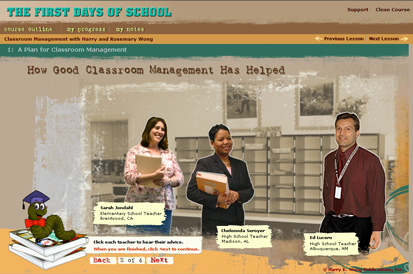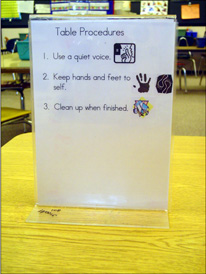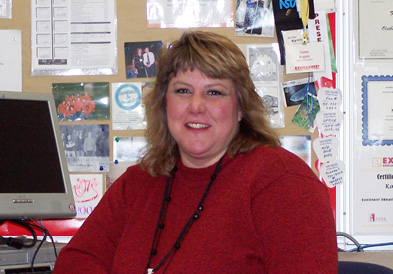|
 |
Effective Teaching... by Harry and Rosemary Wong
To print: Select File and then Print from your browser's menu
------------------------------------------------------------------
This article was printed from Teachers.Net Gazette,
located at https://teachers.net.
------------------------------------------------------------------
March 2007
Classroom Management Applies to All Teachers
“I don’t see how this applies to me. I teach high school and this all looks so elementary,” is a statement we hear all too often – with embarrassment. When we respond to these teachers and tell them we want to help if they would tell us what they want as a high school teacher, we never hear from them. Follow us and you may understand why we never get an answer.
An Aha Moment
Stacey Allred is a special education teacher in Hobart, Indiana. Her success as a teacher is based on her knowledge and experiences that special education teachers, as well as all teachers, must be effective classroom managers to become effective teachers.
She says that what we, the Wongs, teach in our books, videos, and eLearning course about classroom management is so easily connected to all teachers whether a person is teaching in a regular classroom, a resource setting, or in an inclusive setting. Children with behavior problems or learning problems need structure and routine even more than the typical student! She continues that structure is simply a form of task analysis, which is the breakdown of a task step by step. Read October 2004, “The Saints of Education,” for a similar story.
Stacey also teaches at Indiana University Northwest and her students are general education students. She focuses on assessment and remediation of students with mild handicaps and learning disabilities, which she teaches to special education teachers as a method of teaching. Her class also focuses on procedures and routines as the basis for classroom management.
To see what she teaches, click here for a sample of some her visuals.
She uses an “Aha” (pronounced Ah-Ha) method to engage her students. She distributes “Aha” sheets and stops at intervals during her presentation and discussion to allow the students to write “Aha” or light bulb moments on how they can implement what they see or hear to their own classrooms.
For instance, effective teachers know about using “bell work” to get their students to work when class starts. Click here or see page 121 in The First Days of School for an explanation of this technique.
Five high school physical education teachers at Spaulding High School in Rochester, New Hampshire, heard Harry at a meeting talk about bell work. They did not complain that they did not have a chalkboard to write down the bell work assignment. They had an Aha moment. When their students walk into the gym, this is what they see:
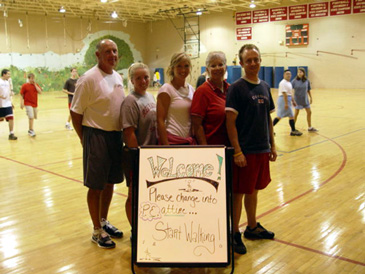
By the way, the teachers are not standing behind the assignment when the students walk in. They posed for the picture knowing that Harry would show this picture all over the world when he lectures. They wanted to show how well they can think and implement.
If you want to see how another high school physical education teacher implements this technique, please go to November 2001, “The Effective Teacher Thinks.”
Like Stacey, we do not believe in giving teachers pat answers on what to do. We would prefer to share what other teachers have done successfully in their own classrooms, regardless of grade level and subject matter, and allow each teacher to generate his or her own classroom management plan.
This is the approach we take in our eLearning course on Classroom Management. We present how over 30 teachers manage their classrooms, ranging across the spectrum of teachers. Over half of the examples are high school teachers. In fact, in the opening graphic two of the three teachers are high school teachers.
Our assignment to the person taking the eLearning course is to reflect on what these teachers are doing and create a binder with their own classroom management plan.
When Susan Riedel of Galveston, Texas, finished the online course, she said:
“I have come away with a great binder that will help me
organize my classroom. This was truly an exciting course.”See www.ClassroomManagement.com for more information.
Procedures, Procedures, Procedures,
Effective teachers have procedures and these procedures are part of a classroom management plan. Procedures transcend all grade levels and all academic subjects. Classroom management applies to ALL teachers.
What we share is not just for elementary teachers. It is not just for secondary teachers. It is for all teachers.
In fact we received a letter recently from a college instructor, Susan Monfet, of Montclair State University and Bloomfield College in New Jersey. She says, “I teach Classroom Management. In searching for information for teaching the course, I came across your book and the online program. I have since adopted your book as a text for the class. The information was not only useful for my students for the management of their own classrooms, I also found the information useful for me as a college instructor in managing my college classes.”
Regardless of the grade level or subject area taught, all well managed classrooms have similar procedures, such as:
Bell work assignment
Opening morning procedures
Students entering procedures
Students leaving procedures
Walking in the hall procedures
Procedure if student finishes early
Getting the class’s attention
Quieting the class procedure
Listening to/responding to questions
Getting the teacher’s attention
Roll taking procedure
Collecting papers
Distributing papers
Disaster drill procedures
End of class/day dismissal procedures
And more…
Investing in Student Success
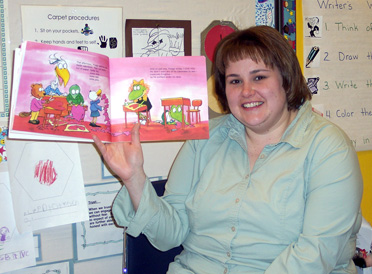
Sue Moore teaches kindergarten in Hobart, Indiana. She was present at one of Stacey Allred’s classes and was introduced to The First Days of School and saw the video series, How to Be an Effective Teacher. She said she had an immediate Aha, because she recognized the positive impact that specific procedures and routines could have in her kindergarten classroom.
She reflected on areas in her classroom that needed consistent procedures the most. She thought. She implemented.
She began by writing and implementing carpet time, center time, and table procedures. Later, she added restroom and coatroom procedures.
These procedures were so successful that she incorporated procedures into her Writer’s Workshop curriculum.
Then she had a magnificent Aha. She made visual charts to remind her students of all the procedures. These were created because she wanted all of the procedures to be seen and understood by all of her students: non-readers, as well as students with special needs.
She searched for clip-art to illustrate each procedural step and then hung the charts at the appropriate locations within the classroom. Additionally for the table procedures, she placed them in stands so everyone at the tables could see them. It worked great!
Click here to see more of her classroom procedures.
She taught the procedures using the three-step method explained on page 177 of The First Days of School. She happily remarked that the procedures became automatic routines in several weeks.
Sue said that the time invested in practicing and rehearsing the procedures was well worth it! For instance, when one of her students ran from the classroom to the coatroom, another student corrected him by pointing to our coatroom procedure sign and reminding him that our first procedural step is to “Walk.” She says, “My young students have become much more independent and are very clear of my expectations. Consequently, I have more opportunity during the school day for individualized instruction.
“My kindergarten classroom is on the road to becoming a well-oiled learning machine!”She Stole a High School Technique
Before going further, please review last month’s article, “Students Want a Sense of Direction.”
We featured three teachers; two of them were Diana Greenhouse and Karen Rogers. Diana used a technique called “Inner-Outer Discussions." This is how she got or “stole” the technique. She has a daughter in tenth grade and this technique was used by her high school English teacher.
Diana took this high school technique and modified it for her fifth grade class.
Procedures Are a Work in Progress
Karen Rogers is a high school teacher in Kansas. Last month she shared her scoring guide or rubrics in "Student Wants a Sense of Direction."
This month we are excited to share her first day of school script or classroom management plan.
Click here to see a Power Point presentation of her classroom procedures.
Here are some of Karen's comments about her presentation.
1. As a master record of classroom procedures
It is a great feeling to have all my classroom procedures written down in one location. On Power Point, my list is easily accessible and can be modified as needed.
2. At the beginning of the school year
I think it is very important to explain, rehearse, and reinforce procedures at the very beginning of the school year and throughout the year as well. I spend about 20 minutes explaining procedures with the Power Point. Sometimes I give students points for writing down the most important procedures, such as entering class, quieting the class, and dismissing class.
3. As a reminder, or reinforcer
I print, post, or refer to certain slides on the Power Point to reinforce a procedure. For example, if students start lingering at the door or talk as they enter the classroom instead of getting seated and getting to work, I remind them of the proper procedure to enter the classroom. Sometimes I will hold up a printed copy of the slide. Then I check on them the next day. I either thank them for doing it properly, or I remind them of the procedure again and have them practice the proper procedure for entering the classroom.
4. Something to share with others
The key to good classroom management is having procedures and routines in place. I am happy to share with other teachers who can use my Power Point presentation to customize and create their own master list of procedures.
5. Work in progress
I review and revise my classroom procedures every August before school starts. It helps me reset myself so I am prepared for students. Procedures and routines improve the classroom climate and maximize the learning time for students.Karen says, “Procedures are such an important part of classroom management. They work at all levels. In my high school classroom, if I don't reinforce a procedure throughout the year (for example, being seated for dismissal) it becomes a management problem later in the school year when I spend time at the end of the hour repeatedly saying, "Be seated."
“With procedures, I take time to remind students about the dismissal procedure, I practice it that day, and I thank students for doing it right. Students get used to it and they expect it.
“I simply and strongly believe in the power of procedures. I used to lack confidence thinking teaching procedures seemed like I was talking down to high school students. However, if I didn't rehearse and reinforce, I regretted it later.
"Now I embrace the fact that I teach procedures in the classroom and I make a big deal about procedures. It gives me student engagement.
My high school classroom flows much more smoothly with procedures than without!
Observe, Reinvent, and Implement
What works in a kindergarten class works in any other classroom.
What works in a high school classroom also works in any other classroom.
All you have to do is observe what successful teachers do, regardless of what or where they teach. Then you prepare yourself to have an Aha moment and modify the technique for your classroom. It’s then all yours to use with success.
And don’t forget to share your success with others. Allow others to observe what you do in the classroom, share a list with a colleague, demonstrate a technique at a workshop so that others can steal from you and modify your work for their classrooms.
Become a catalyst of success for teachers—no matter what
grade or subject matter they teach!
Harry & Rosemary Wong products: http://EffectiveTeaching.com
This printable version is provided for the convenience of individuals.
Reproduction of multiple copies requires permission from editor@teachers.net.
Canter Courses
Choose the Masterís Degree Program that Fits Your Interests and Your Schedule
AIU Online
Master's, Bachelor's, Associate's. Get the degree you need to pursue the career you'll love!
University of Phoenix Online
University of Phoenix Online. The campus is virtual. The degree is real.
Jones Intl University Online
Designed for education professionals in corporate training, educational leadership, and K-12 teaching and administration
Home Search Contacts Chatboards Lessons Mailrings Jobs Refdesk Webring PR Advertise
© 1996 - 2004. All Rights Reserved. Please review our Terms of Use, Mission Statement, and Privacy Policy.
# 187042

